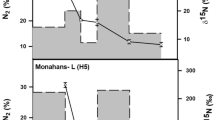Abstract
Samples are available from 37 stony meteorites falling in China. Twenty-two chondrites are examined in terms of chemical and mineral compositions, cosmogenic nuclides, formation and exposure ages, impact effect and chondrule textures. On the basis of chemical-petrologic features these chondrites are classified asE 4 (Qingzhen),H 5 (Jilin, Changde, Shuangyang, Anlong, Xinyi and Yangjang),L 6 (Renqiu, Junan, Heze, Rugao and Nei Monggol) andLL 6 (Dongtai).
E4 is characterized by high iron and sulfur, with the former occurring mainly as Feo and FeS. FromH5 throughH6 toLL6, iron and nickel decrease gradually while FeO and the ratio of Fe silicate to total iron increase gradually. indicating a general increase in the orderE-H-L-LL in the degree of oxidation at the time of formation.
E4 consists mainly of enstatite and, to much less extent, free SiO2 but olivine is hardly to be found. The olivine proportions amount to 29.07, 41.98 and 51.36 percent inH5,L6 andLL6 respectively, with Fa increasing from 17 to 27 percent.
Recrystallization has been noticed to different degrees inH 4,H 5,L 6 andLL 6 chondrites. The extent to which the original structure disappears and the boundaries of chondrules become indistinct decreases from type 6 through type 5 to type 4, reflecting different degrees of thermal metamorphism. Major minerals in the meteorites all exhibit signs of low to medium shock metamorphism.
Specific activity, depth effect and orbit effect are also measured on some chondrites that have fallen in recent years and some new information has been obtained with respect to the orbit and source region for meteorite parent bodies in space. This results show that the environment of formation ofE group may be nearer to Mars than that ofO group.
Each chemical group of chondrites has its own evolutionary history, and chondritets of different chemical groups may have originated from parent bodies of different compositions. Or owing to the differentiation caused by thermal melamorphism, various kinds of meteorites may be derived from a common parent body. From this argument it is suggested that five stages may be recognized during the formation process of chondrites.
Similar content being viewed by others
References
卞德培: 1978, 我国已知陨石的初步统计. «地球化学», 第3期.
王道德、 谢先德: 1977, 清镇顽火辉石球粒陨石物质组成和球粒 结构的初步研究. «地球化学», 第4期.
中国科学院吉林陨石雨联合考察组: 1977, 吉林陨石雨的初步考察. «中国科学», 第1期.
长春地质学院、 吉林省地质科学研究所: 1976, 中国吉林陨石雨—物质成分和结构的初 步研究. «地质学报», 第2期.
中国科学院贵阳地球化学研究所石实验室: 1974, 安龙球粒陨石的物质组成和球粒结构. «地球化学», 第2期.
王道德、 欧阳自远、 曹鉴秋: 1977, 常德陨石雨物质成分和球粒结构的初步研究. «地球化学», 第4期.
常子文、 闻传芬、 顾芷娟: 1975, 新沂球粒陨石的物质组成和结构. «地质科学», 第4期.
常子文: 1966, 我国四块球陨石的初步研究. «地质学报», 第46卷, 第1期.
王道德、 谢先德、 伊世同: 1977, 任邱球粒陨石. «地球化学», 第4期.
王锡岳、 李晓卿、 王思潮: 1974, 东台陨星的分析. «天文学报», 第15卷, 第1期.
Van Schmus, W. R. and Wood, J. A.: 1967, A chemical petrologic classification for the chondritic meteorites, “Geochim. Cosmochim. Acta.” Vol. 31.
Van Schmus, W. R.: 1969, The mineralogy and petrology of chondritic meteorites. “Earth Science Reviews.” Vol. 5, No. 3.
Wasson, J. T.: 1974, Meteorites: classification and properties, Springer-Verlag Berlin Heidealberg. New York, p. 18.
McCall, G. J.: 1973, Meteorites and origin, David & Charles: Newton Abbot. p. 156.
Urey, H. C. and Craig, H.: 1953, The compostion of the stone meteorites and the origin of the meteorites. “Geochim. Cosmochim. Acta.” Vol. 4.
Elbert, A. King: 1976, Space Geology, an Introduction. John Wiley & Sons, Inc. New York, London. Sydney. Toronto. p. 25.
中国科学院原子能研究所、 地球化学研究所陨石分析组: 1976, 陨石、 超基性岩、 花岗岩及其主矿物中某些微量元素的仪器 中子活化分析. «地球化学», 第2期.
Hiroshi Wakita and Schmitt, R. A.: 1970, Lunar anorshosites: rare-earth and other elemental abundance. “Science,” Vol. 170
Hiroshi Wakita and Schmitt, R. A.: 1970, Rare earth and other elemental abundances in Allendemeteorite. “Nature,” Vol. 227. No. 5257.
Wahl, W.: 1950, The statement of chemical analyses of stone meteorites and the interpretation of the analyses in terms of minerals. “Miner. Mag.”, Vol. 29.
Mason, B.: 1967, Extraterrestrial mineralogy. “Amer. Minerologist” Vol. 52, No. 3 and 4.
张培善执笔: 1978, 吉林陨石雨物质成分研究并讨论其对地球 起源和演化问题的启示. «地质科学», 第2期.
中国科学院贵阳地球化学研究所K-Ar年 龄实验室: 1978, 吉林球粒陨石K-Ar年龄与Ar38暴露年龄研究. «地球化学», 第3期.
王道德、 谢先德: 1978, 吉林陨石的热变质及冲击变质研究. «地球化学», 第1期.
Carter, N. L., et al.: 1968, Deformation of olivine in stony meteorites. “Jour. Geophi. Research.” Vol. 73.
欧阳自远、 谢先德、 王道德: 1978, 吉林陨石形成和演化轮廓. «地球化学», 第1期.
Author information
Authors and Affiliations
Rights and permissions
About this article
Cite this article
Wang, D., Ouyang, Z. & Hou, W. A preliminary study on mineralogical and chemical compositions of some chondrites falling in China. Geochemistry 1, 186–199 (1982). https://doi.org/10.1007/BF03180329
Issue Date:
DOI: https://doi.org/10.1007/BF03180329



